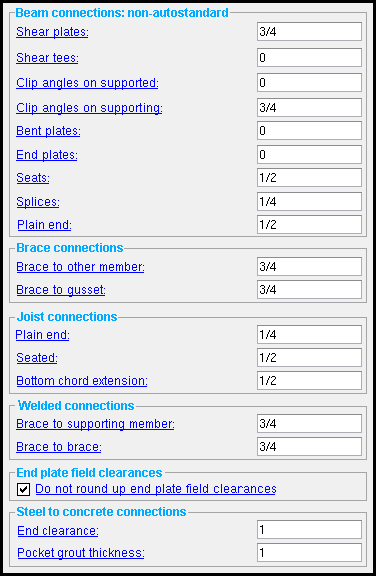The Field Clearances window ( Job Settings )
| Settings on this window are read-only . They tell you how this window has been set up for this Job in a full-featured SDS2 program . |
Also see :
- User defined connections (set up using this window)
- Beam specified connections (set up using this window)
- Auto Standard Field Clearance (not set up using this window)
page 1 | contents | home > project settings > job > design > | classic | top
Method 1 : Home > Project Settings > Job > Design > Field Clearances .
Methods 2, 3 & 4 : In Modeling or the Drawing Editor , choose Settings > Job Settings > Field Clearances (classic), or use a keyboard shortcut , or click the icon.
page 1 | contents | home > project settings > job > design > | classic | top
------ Beam connections: non-autostandard ------
Shear plates: Field clearance is the distance (in the primary dimension " Units " or in other units ) between the end of the beam to the face of the supporting member or, for an extend-past-flange beam-to-beam connection, the distance between the beams. This field clearance applies to shear plates whose specifications are entered on the Beam Review window and to user defined shear plates.
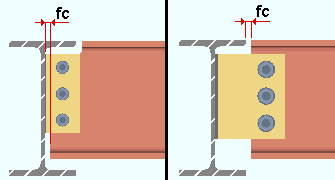
|
fc = field clearance |
Please note: So long as an " Automatic minus dimension " is used, connection design calculates the distance from the face of the support to the column of holes in the shear plate using the field clearance shown here plus the beam's end edge distance. This is then rounded up to the next 1/4 inch (or even millimeters for metric). As a result, the actual calculated field clearance may be larger than specified, but not less. For shear plates on a sloping beam with a square cut end, the calculated field clearance will never be more than 1/8 inch larger than specified here.
Shear tees: The distance (in the primary dimension " Units " or in other units ) from the face of the connection to the face of the supporting member. This applies to shear tees that field bolt to the supporting member (beam or column) and attach in the shop to the supported member (the beam) and to user defined shear tees.
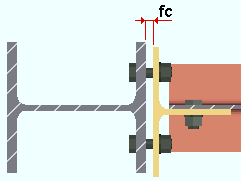
|
fc = field clearance |
Clip angles on supported: The distance (in the primary dimension " Units " or in other units ) from the face of the connection to the face of the supporting member. This applies to clip angles that field bolt to the supporting member (beam or column) and attach in the shop to the supported member (the beam). This field clearance applies to shop-attached-to-supported clip angles whose specifications are entered on the Beam Review window and to user defined clip angles.
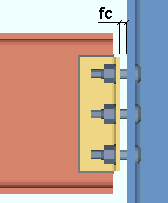
|
fc = field clearance |
Clip angle on supporting: The distance (in the primary dimension " Units " or other units ) from the face of the supporting member to the web of the beam that the clip angles field bolt to. This applies to clip angles that shop weld to the supporting member (beam or column) and field bolt to the supported member (the beam). This field clearance applies to shop-attached-to-supporting clip angles whose specifications are entered on the Beam Review window and to user defined clip angles.
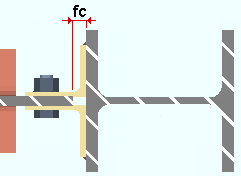
|
fc = field clearance |
Bent plates: The distance (in the primary dimension " Units " or in other units ) from the face of the connection to the face of the supporting member. This applies to bent plates that field bolt to the supporting member (beam or column) and attach in the shop to the supported member (the beam). This field clearance applies to bent plates whose specifications are entered on the Beam Review window and to user defined bent plates.

|
fc = field clearance |
End plates: The distance (in the primary dimension " Units " or in other units ) from the face of the connection to the face of the column. This field clearance applies to end plates whose specifications are entered on the Beam Review window and to user defined end plates.
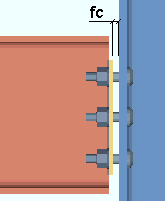
|
fc = field clearance |
Seats: Field clearance is the distance (in the primary dimension " Units " or in other units ) from the end of the beam to the face of the column.
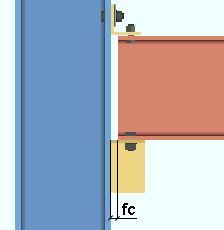
|
fc = field clearance |
Splices: Field clearance is the distance (in the primary dimension " Units " or in other units ) between the two beams.
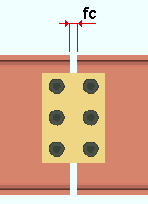
|
fc = field clearance |
Plain end: The distance (in the primary dimension " Units " or other units ) between the beam and the beam or column that the beam frames to. This applies when the beam's " Input connection type " is ' Plain end '.
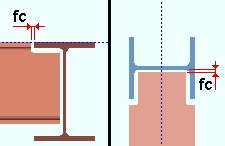
|
fc = field clearance |
page 1 | contents | home > project settings > job > design > | classic | top
------ Brace connections ------
Brace to other member: The field clearance is the distance (in the primary dimensioning " Units ") between the end of the brace and the face of the supporting beam or column. Or it is the distance between the end fitting on the brace and the face of the supporting beam or column. Or it is the distance between the end of the brace and the clip angle that bolts the gusset to the supporting member.
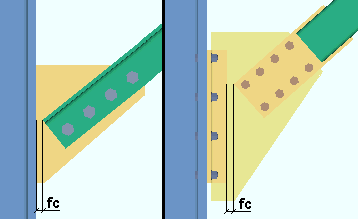
|
fc = field clearance |
Brace connections to gusset: The field clearance is the distance (in the primary dimension " Units " or in other units ) between the end of the brace and the edge of the gusset plate. This applies to any pipe or tube horizontal brace or when the " Pipe/tube end-fitting " on a pipe or tube vertical brace is a ' Paddle plate ' or ' Bolted '.
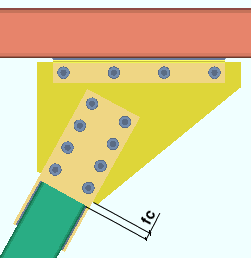
|
fc = field clearance |
------ Joist connections ------
Joist to beam connections: The distance parallel with the workline of the joist (in the primary dimension " Units " or other units ) from the input point of the joist ( X ) to the top of the joist's top chord. This distance is measured along the top of the top chord of the joist.
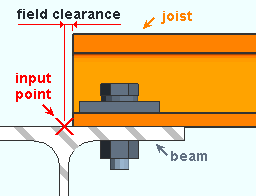
|
joist to beam |
Applications: This clearance may be applied when the joist " Input connection type ' is ' Plain end ' or ' Bearing ' or ' User defined '.
Note 1: This clearance affects the " Overall Length " reported in the Joist Report as well as positions the joist on the beam's top flange.
Note 2: The value entered here can impact the connection failure message " Beam flange too narrow for min joist bearing ."
Note 3: The joist to beam field clearance is irrelevant when the joist's top chord is extended.
Seated: The distance parallel with the workline of the joist (in the primary dimension " Units " or other units ) from the top edge of the joist's top chord to the face of the supporting member.
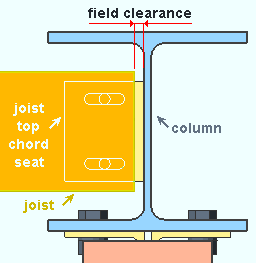
|
seated joist |
Note: Since the joist seat field clearance is measured parallel with the slope of the joist, the actual distance between the top chord and the column will always be a horizontal distance if the column is perfectly vertical. That horizontal distance may be less than this field clearance. Also, since the joist seat field clearance is measured along the top of the joist's top chord, the bottom of the joist's top chord may be closer to the column than the field clearance.
page 1 | contents | home > project settings > job > design > | classic | top
------ Welded connections ------
| These options apply when the " Input connection type " on a vertical brace is ' Welded ' and the vertical brace is a ' Back to back ' double-angle to the stem of a W tee (or S tee) chord member. Typically a W tee beam is used as the chord member. |
Brace to supporting member: Field clearance is the distance (in the primary dimension " Units " or in other units ) from the end of the back-to-back double-angle vertical brace to the k distance of the W tee or S tee. This applies to 1-point, 2-point and 3-point vertical bracing.
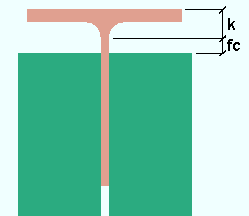
|
fc = field clearance |
Brace to brace: Field clearance is the distance (in the primary dimension " Units " or in other units ) between any two adjacent back-to-back double-angle braces in a 2-point or 3-point branch.
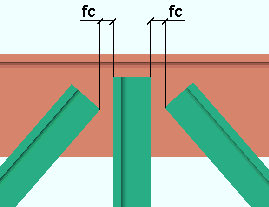
|
fc = field clearance |
page 1 | contents | home > project settings > job > design > | classic | top
------ End plate field clearances ------
Do not round up end plate field clearances: ![]() or
or ![]() . This option applies to field clearances on all system-designed end plates, auto standard as well as non-autostandard.
. This option applies to field clearances on all system-designed end plates, auto standard as well as non-autostandard.
If this box is checked (
), connection design in a full-featured SDS2 program will generate all end plate connections without using the rounding procedure that could result in a 1/16-inch (or 1-mm) extra gap being added to an end plate's field clearance. As a result, an end plate's field clearance will more likely be as specified for " End plates " on this window, or on the Auto Standard Connections setup window. Warning : If you do this in an existing Job, the lengths and piecemarks of affected members may change.
If the box is not checked (
), connection design may, for particular situations, continue to add a 1/16-inch (or 1-mm) extra gap to the user-specified field clearance. The additional gap will most likely be added if your beams are sloping or if your primary dimension " Units " are set to ' Metric '.
page 1 | contents | home > project settings > job > design > | classic | top
------ Steel to concrete connections ------
End clearance: The distance (in the primary dimension " Units " or other units ) from the end of the beam to the face of the embed or the pocket. This affects the " Automatic minus dimension " that is applied to a beam with an embed bearing connection. A user in a full-featured SDS2 program can enter an " Input minus dimension " to override this end clearance for individual beams.
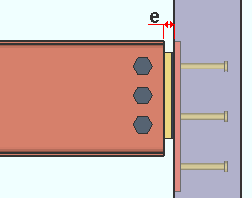
|
e = end clearance |
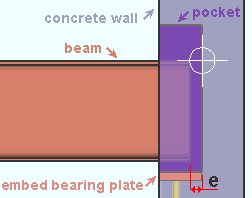
|
e = end clearance |
In a full-featured SDS2 program . . .
Beam-to-concrete bearing connections: A bearing plate or angle or channel embed can be created in the model from the Beam window by selecting ' Bearing ' as the " Input connection type " and making an " Embed schedule entry ." You are able to make an " Embed schedule entry " only if that beam's end frames to a concrete wall or panel.
Joist-to-concrete bearing connections: A joist end pocket is created in a concrete wall or panel when ' Bearing ' is selected as the " Input connection type " on the Joist window and the joist top chord frames to the concrete wall or panel.
Pocket grout thickness: The distance (in the primary dimension " Units " or other units ) from the bottom of the beam to the bottom of the pocket. For a joist, this distance is from the bottom of the joist's shoe to the bottom of the pocket.
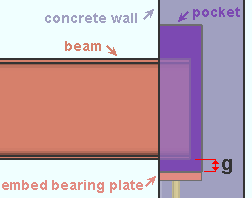
|
g = pocket grout thickness. The grout bearing thickness ( g ) positions the bottom of the pocket and also positions the embed (a bearing plate in this example). A bearing embed can also be an angle or a channel. |
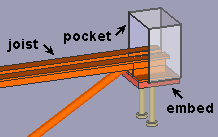
|
A joist top chord supported by a bearing embed plate (see " Schedule entry "). The " Pocket grout thickness " in this example is ' 0 ' (zero), a value which positions the embed flush with the bottom of the shoe. |
In a full-featured SDS2 program . . .
Beam steel-to-concrete connections: A beaing plate or angle or channel embed can be created in the model from the Beam window by selecting ' Bearing ' as the " Input connection type " and making an " Embed schedule entry ." You are able to make an " Embed schedule entry " only if that beam's end frames to a concrete wall or panel. For a beam, this field clearance sets the value that is entered to " Grout thickness " when that option is unlocked (
) in the "
Beam End Pocket " leaf.
Joist steel-to-concrete connections: A joist end pocket is created in a concrete wall when ' Bearing ' is selected as the " Input connection type " on the Joist window and the joist top chord frames to the concrete wall or panel. For a joist, this clearance sets the " Grout thickness " when that option is unlocked (
) in the "
Joist End Pocket " leaf.
page 1 | contents | home > project settings > job > design > | classic | top
